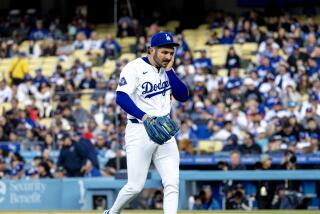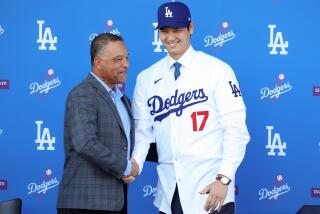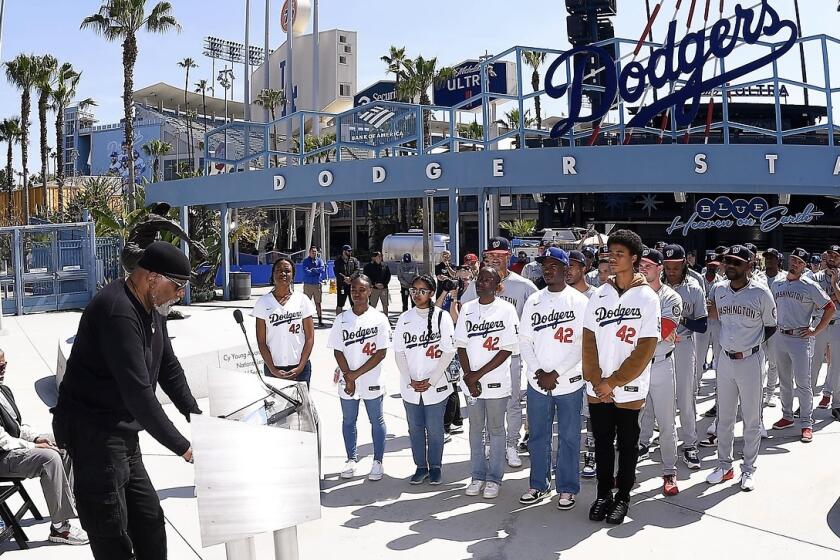A sullied part of Dodgers’ history
The scene is chilling in its deceit, and startling in its chaos.
In July 1999, a Dodgers strength and conditioning coach gathered five Dodgers minor leaguers in an Albuquerque apartment and watched them shoot themselves full of steroids.
A few months later, the manager of that triple-A team resigned because he felt his beloved organization was out of control.
FOR THE RECORD:
Major League Baseball: A chart in Friday’s Sports section on prominent Dodgers named in the Mitchell Report on performance-enhancing drug use in baseball said that the Dodgers traded Paul Lo Duca to the New York Mets in July 2004. The Dodgers traded Lo Duca to the Florida Marlins.
That manager’s name was Mike Scioscia.
As the Mitchell Report revealed Thursday, steroids aren’t only about home runs, they’re also about strikeouts.
Nobody in the report whiffs more than the Dodgers of the late 1990s and early 2000s, the new Fox property being painted as a drug-addled bunch that either ignored steroids or helped buy them.
According to interviews with alleged steroid suppliers, Paul Lo Duca wasn’t so much a clubhouse leader as a clubhouse pusher.
Kevin Brown wasn’t just a curmudgeon, he was a drug cheat.
Eric Gagne wasn’t only about goggles, but syringes.
Is it any wonder that the man who has since become one of baseball’s best managers couldn’t stand the madness?
Scioscia said he was not aware of the alleged incident in Albuquerque, but agreed that such craziness was typical of an organization that he left before he could be fired.
Scioscia, of course, eventually landed in Anaheim, where he has led the Angels to a World Series championship and annual contention while the Dodgers have won one playoff game since.
“I only vaguely remember the strength guy, they had a lot of them come through back then,” Scioscia said. “But if that happened, it’s very disappointing.”
Todd Seyler, a Dodgers strength and conditioning coach, said he met with some Albuquerque prospects in May 1999, which was Scioscia’s first and only season as the Dukes manager.
“Seyler began talking with five of the Dukes players about using performance-enhancing substances,” the report read. “All five players expected to be called up to the Dodgers later in the season and they all wanted to be in ‘peak physical condition.’ ”
According to the report, the players were catcher Paul Lo Duca and pitchers Ricky Stone, Mike Judd, Matt Herges and Jeff Williams.
“Before a game in mid-July, 1999, Seyler said the players met to inject themselves with the steroids,” the report read. “The five players and Seyler all injected themselves with steroids at the apartment.”
According to the report, by the 2000 season, the Dodgers were filling up with players who either had used steroids, or would later use steroids.
Mentioned in the report were nine players on the 2000 team, and eight players on the 2001 team.
Alas, only the Dodgers could have that many alleged juicers and still not make the playoffs, with the team winning 86 games each season.
According to the report, new catcher Todd Hundley was buying the drugs from former New York Mets clubhouse attendant Kirk Radomski.
Hundley introduced Radomski to Lo Duca, and it seemed Lo Duca introduced Radomski to the others, from Adam Riggs to Brown to Herges.
By the time Gagne and Brown were at their Dodgers peak in the 2003 season, it was obvious to me that both players were probably on steroids.
It was obvious to the Dodgers management that both players were probably on steroids.
We would even talk about it while watching their bulging, straining bodies from the dugout during batting practice.
But the players would admit nothing, so there was nothing I could write.
Management could not subject them to testing, so there was nothing they could do.
“We weren’t able to test, and we had no evidence,” said Bob Daly, who served Fox as chairman of the team during that time.
With the union threatening grievances if management attempted to make its own rules, teams had little control of their players’ drug habits, a fact that became starkly clear in the pile of Mitchell Report evidence.
Among the pieces is a steroid thank-you note written from Lo Duca to Radomski.
A note written on Dodger Stadium stationery.
“Call me if you need anything!” Lo Duca cheerfully wrote.
There also are reports of steroids being sent directly to Dodger Stadium, and a note about a former Dodgers assistant trainer named Matt Wilson looking the other way when a player said he was interested in the drug.
At the end of the 2003 season, then-general manager Dan Evans clearly was fed up with the issue, and the Mitchell Report contained notes from an off-season meeting that revealed concern over use by Gagne, Brown and Lo Duca.
Give Evans credit for finally trading Brown to the New York Yankees.
And, the following summer, give new boss Paul DePodesta credit for trading Lo Duca to the Florida Marlins.
I wrote that sending Lo Duca out during the middle of a pennant race was one of the worst trades in team history. If DePodesta made the trade based on steroid use, then I stand corrected.
Judging from his track record here, the longer Lo Duca remained with the team, the more players would have been on the juice.
The sour history of DePodesta’s reign also may have to be somewhat rewritten.
But then, so will the history of the entire Dodgers team during that era.
You can no longer believe Gagne’s record 84-game save streak. Sorry, it’s as phony as he was.
You can no longer believe Lo Duca’s 25 home runs and 90 runs batted in of 2001. Nice guy, but in the ethics department, he finishes last.
You can no longer believe Brown’s 2.39 earned-run average in 2003. More memorable will be the temper tantrums that were, perhaps, ‘roid rage.
It’s a sad day in baseball, a sadder day in Chavez Ravine.
The best hope here is that owner Frank McCourt, whose reign began with the advent of steroid testing, has done enough housecleaning to rid the organization of all the pushers and poppers and punks.
That, and the fact that there is one notable Dodgers name that is not contained in the 409-page report. Believe me, I looked.
Jose Lima is not in there.
The Dodgers’ only playoff win in 20 years still stands.
For now.
Bill Plaschke can be reached at bill.plaschke@latimes.com. To read previous columns by Plaschke, go to latimes.com/plaschke.
ON THE WEB For video, message boards and the text of the entire Mitchell Report, go to latimes.com/sports.
More to Read
Get our high school sports newsletter
Prep Rally is devoted to the SoCal high school sports experience, bringing you scores, stories and a behind-the-scenes look at what makes prep sports so popular.
You may occasionally receive promotional content from the Los Angeles Times.







